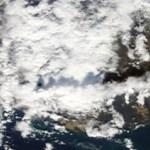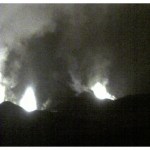
The eruptive plume from Eyjafjallajökull taken Holsvelli webcam. Image courtesy of Mattias Larsson.
Sorry to disappoint everyone visiting to blog while they sit at any number of airports around the world, but the eruption at Eyjafjallajökull appears to still be going strong. The Icelandic Met Office is heading up to the volcano to conduct a survey of the crater area to find out (1) what it looks like and (2) how much new water (i.e., ice) is there available for the erupting magma. More water is likely to mean more explosive eruptions in this phreatoplinian style - however, like I…
Hard to believe, but there is other volcano-related news in the world ...
So, with all deference to Eyjafjallajokull, here it is:
Dome collapse on Colima in Mexico, image taken March 30, 2010.
The new Smithsonian/USGS GVP Weekly Volcano Activity Report was issued, with news about increasing signs of activity at Egon in Indonesia, a possible plume at Miyakejima in Japan and more dome growth at Soufriere Hills.
A study on the economic effect of a new Vesuvius eruption was released and the finding show the potential for a staggering $24 billion of economic damage directly related to an…
The ash plume from the 2010 Eyjafjallajökull eruption.
To say that the Eyjafjallajökull eruption has become the most significant volcano-related news story of the year would be an understatement. There has been wall-to-wall coverage on every major media outlet, dissecting everything from the effect of ash on jets, to the effect of ash on people, to wildly premature commentary on the climatic effect of the eruption to the potential place in history of this event. The eruption is affecting a wide swath through society: the European economy may take a hit of billions of dollars due to…
A brief, non-volcano-related note, but sometime between 12:30 and 1 PM EDT today, Eruptions will pass 1,000,000 page views since joining ScienceBlogs in March of 2009. I wanted to thank everyone who has made the blog such a fun thing to do and who pick up on reporting the events when I'm swamped. You've made it into a community of volcanophiles unto itself.
Now, back to the volcanoes!
The ash from the Eyjafjallajökull eruption as it spreads over Europe on April 15, 2010.
The newly-subglacial Eyjafjallajökull eruption of 2010 has now begun to be felt outside of Iceland. The ash being thrown into the atmosphere from this explosive phase of the eruption has prompted officials in the United Kingdom, Ireland and Norway to close the airspace above their nations due to the threat that ash poses to jet aircraft. Remember, the silica glass shards that make up most ash can melt inside jet engines, causing them to stall - which could lead to crashing. Luckily, so far we have not…
The steam and ash plume from the Eyjafjallajökull subglacial eruption that started early morning, April 14, 2010.
Well, after the brief respite when there was speculation Eyjafjallajökull-Fimmvörduháls eruption might be over, we now know what was going on. After the original fissures ceased activity, the magma found a new route to the surface, this time underneath the Eyjafjallajökull glacier. Eruptions readers last night watched as an earthquake swarm arrived underneath the icecap, which prompted Icelandic officials to start evacuating people from the area around the volcano (photo…
The Eyjafjallajökull-Fimmvörduháls eruption on April 7, 2010.
Just as we were speculating that the Eyjafjallajökull-Fimmvörduháls eruption might be over, Icelandic officials may have ordered an evacuation for towns (icelandic) in the area (but information in english is scant). There have been a recent swarm of shallow earthquakes underneath the Eyjafjallajökull ice cap - and if there is any chance that this could be signs of a new eruption under the ice, evacuations are justified. This could mean a jökulhlaup could be generated. These glacial floods are highly destructive, so getting…
The Eyjafjallajökull-Fimmvörduháls eruption at night on April 10, 2010.
I mentioned this earlier in the Monday Musings column, but the Eyjafjallajökull-Fimmvörduháls eruption in Iceland that started last month seems to be at a nadir of activity since its inception. This is being interpreted by the Icelandic Met Office as a sign that the eruption itself may be winding down after less than a month of activity - the earthquakes and inflation associated with the eruption appears to be subsiding along with the actual eruptive activity. Now, there is always the chance that the fissure will…
Lots to do!
Tourists flock to the Eyjafjallajökull-Fimmvörduháls in Iceland.
The media does love the term "supervolcano", and a number of Eruptions readers sent me a link to the article on the dreaded submarine "supervolcanoes". I would delve into this article from Live Science, but it sadly again does a dreadful job with a lot of this - remember, "supervolcano" is a made-up word by the BBC with no strict definition, so trying to say there are a dozen supervolcanoes worldwide is just silly. And why does it take multiple paragraphs and multiple mentions of "scientists" before they get a…
Idunn Mons on Venus with recent emissivity data from the Venus Express overlaid on the topography, suggesting recent lava flows.
NASA released images today that suggest that the surface of Venus has experienced some relatively recent volcanic events (geologically speaking). By examining the surface in infrared, the Venus Express, launched by the European Space Agency (ESA) has found that three spots on the surface exhibit signs of recent volcanism. The long-and-short of the research lead by Dr. Sue Smrekar of JPL is that a number of Venutian lava flows (shown above on Idunn Mons) show less…
A view of the steaming Mt. Etna, taken on April 8, 2010 by Dr. Boris Behncke.
Eruptions reader and member at Italian National Institute of Geophysics and Volcanology in Catania, Dr. Boris Behncke, has been keeping many of us appraised on the goings-on at Mt. Etna. A series of earthquakes occurred on April 2-3 along a fault near the north flank of the volcano - 175 earthquakes in all producing some impressive results - and Boris has noted increased "rumblings" at Etna since. This has culminated in explosions and ash April 7-8. Most of the ash appears to be made from merely crushed rock of…
The eruption at Eyjafjallajökull-Fimmvörduháls continues on - the explosive spatter and bomb eruptions at the new central vent (on the second fissure) were impressive all night, making the hikers/cars/aircraft look like mites in comparison. This eruption has, so far, followed the pattern of Hawaiian-style volcanism quite well, so I thought it could be a good time to talk about what exactly Hawaiian-style volcanism is. There is a sequence of events that leads up to and follows the start of an Hawaiian-style eruption - although this sequence can stop at any point along the way - but it is…
Actually, no the volcanoes aren't from space, but pictures of the volcanoes were taken from space. The NASA Earth Observatory has posted three more gems of volcanic activity taken by one of the fleet of earth imagers in orbit:
A recent image of Chaiten taken by EO-1. Image courtesy of the NASA Earth Observatory.
There is a great image of the busy Kamchatkan Peninsula, where four volcanoes are seen erupting in a single image - Kliuchevskoi, Bezymianny, Shiveluch and Karymsky. The plume from Karymsky is especially prominent as a grey streak above the white snow of the Russian winter (albeit…
The steam plume from the new dome on Redoubt, taken in January 2010. Image courtesy of USGS/AVO, taken by Dennis Anderson.
News comes out of Alaska that a small earthquake swarm has begun under Redoubt. This is the second such swarm since the volcano's 2009 activity ceased. Most of the seismicity appears to be near the summit of the volcano, which would suggest that magma might be moving underneath the new dome that is still steaming.
AVO describes the unrest:
"This morning, at roughly 01:44 AKDT (0944 UTC) a series of small repetitive earthquakes began occurring in the vicinity of the…
Quick hits for a Monday morning (however, the week did have a good start).
Lava fountaining on March 27, 2010 at the Eyjafjallajokull-Fimmvörduháls eruption in Iceland.
The Eyjafjallajokull-Fimmvörduháls eruption is still going strong with two active fissure - and a lot of tourists poking around as well. If you watch the webcams closely, you can even see the cars and hikers trekking up near the erupting basaltic fissure (except today, as there seems to be a blizzard). Not to say that people are getting a little, well, nonchalant, but there is a story of serving meals cooked on lava up…
Sunny and 80 here in Ohio today. That could mean only one thing that is likely on everyone's mind. (I suppose there is also this other bit of news that we've been following, too.)
The low, broad shield of Hawai`i's Mauna Loa volcano.
The USGS announced yesterday that inflation at Hawai`i's Mauna Loa appears to have ceased. This prompted the decision to move the alert status at Mauna Loa from "Advisory" to "Normal". This would signify the end of any current activity on the big island's largest volcano - the inflation that had been slowing since 2006 (since 2003 really) finally stopped in…
Mars Reconnaissance Orbiter image of a potential plume on Pavonis Mons.
There are reports tonight that the Mars Reconnaissance Orbiter photographing the Martian surface noticed an odd plume near the summit of Pavonis Mons. The initial guess was that this plume might have been fog or an new impact on the Martian surface, but the continued presence of the plume might suggest that it is not a transient feature. One suggestion is that these could be a volcanic plume.
Now, Mars has been very volcanically active in the past - in fact the youngest flows could be as young as 20 million years old, so…
Superfast entry as I run out the door but ...
The new vent that opened on March 31 at Fimmvörðuhálsi in Iceland. The old vent is to the right in the image and new to the left. Image captured at 5:45PM EDT.
A second fissure has opened at the Fimmvörðuhálsi eruption in Iceland. Check out the webcam and you can clearly see a new set of vents (Icelandic - try Google Translate) on the left hand side of the image - and that wasn't there earlier today. You can see an image of the new vents here.
Thank you to all the Eruptions readers who have been keeping us posted!
As a volcanologist, I am partial to impressive lava flows, especially in volcanoes that erupt material that you'd think wouldn't produce big flows. For example, there are quite a few volcanoes in the Chilean Andes that erupt dacite lavas, which are relatively viscous (sticky), so you might expect it to erupt explosively. However, you can get large dacitic to rhyolitic lava flows, quite commonly, and these large flows are called coulées (a "volcanic dome flow").
Lllullaillaco volcano on the Chile/Argentina border. Note the very prominent coulée with flow levees. Click on the image to see a…
Map showing the location of submarine volcano Marsili, near the Italian coast. Image from INGV.
The subject of submarine volcanism near Italy has come up before here on Eruptions but now it has made the jump into the worldwide media after some claims made by Enzo Boschi, president of the National Institute of Geophysics and Volcanology (INGV).
The long and short of what I can tell from the articles is that Marsili, a submarine volcano in the Tyrrhenian Sea, could be a threat to create a significant tsunami that would hit Italy (amongst other Mediterranean countries). The volcano lies only…


